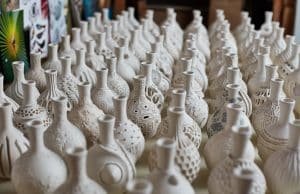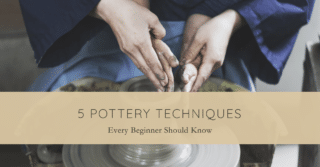As ceramic artists, we often draw inspiration from the rich tapestry of global pottery traditions, from the amphorae of ancient Greece to the moon jars of Korea. However, some of the most profound and enduring ceramic practices come from Indigenous communities, whose methods and motifs are deeply tied to their land, culture, and history. These traditions often remain overlooked in broader narratives of ceramic history, yet they offer invaluable insights into the interplay between creativity, functionality, and spirituality. Today, in celebration of the International Day of the World’s Indigenous Peoples, we’ll explore five unique Indigenous ceramic traditions, showcasing how these communities have used clay to tell stories, preserve heritage, and sustain their way of life for generations.
Acoma Pueblo Pottery
Located in New Mexico, Acoma Pueblo is a collection of four indigenous villages that make up one of the oldest continuously populated communities in the US. The Áakʾùumʾé have inhabited the site for over 2000 years.
Pottery has long held cultural significance to the Áakʾùumʾé, and originally served a primarily functional purpose. Using locally dug clay, pots were hand built using coiling methods, and decorated with natural pigments. Jugs were created to carry water for hunting excursions, while larger pots were made to store seeds and other food items. By the mid 1800s the pottery of the community became highly prized for its superb form, and thin, even walls. The characteristic surface decoration is easily recognized for its use of fine lines, geometric patterns and unique flora and fauna motifs.
The Áakʾùumʾé continue to make pottery in the traditional style today, while also incorporating contemporary making methods such as moulding, as well as evolving motifs. To see examples of today’s Acoma Pueblo Pottery, check out the works of Adrian Trujillo, Franklin Peters, and Sandra Victorino. To gain a broader perspective on Acoma Pueblo Pottery, check out this great video by the Indian Pueblo Cultural Center as well as our profile on Acoma artist Eric Louis!
Dakakari Terracotta Figures
The Dakakari are an agricultural ethnic group located in the Zuru Federation of northwestern Nigeria. They have a long history of ceramic practices, with all clay works being produced exclusively by women. Unique among these practices is the creation of funerary sculptures for notable members of the community. Unlike functional ware, the production of the funerary pieces is restricted to specific families, with the skills being passed from mother to daughter.
While all graves of the Dakakari are marked with the placement of pottery for use in the afterlife, only the burial mounds of high status individuals, such as chiefs, prominent warriors, and important farmers, receive the honor of a figurative sculpture. There are six distinct categories of funerary sculptures produced and they vary in size, complexity, and motif. Once placed, the hand modelled terracotta pieces are poured over with beer or other liquids each year to honor the dead.
Aibom Pottery
The pottery tradition of Aibom Village and the Sepik River region is primarily associated with the Iatmul people, an Indigenous group of Papua New Guinea renowned for their rich artistic heritage. While the Iatmul are more widely known for their intricate wood carvings and ceremonial art, Aibom Village has specialized in pottery-making as a significant form of artistic and functional expression. This is due to significant clay deposits in the area. The village has long been part of a historic trading route, and pottery comprises one of its main commodities. Most popular is the Sago pots, which are used to store Sago flour, a dietary staple throughout the Sepik River region. These vase-like vessels are coil built and decorated with animal, human, or spirit faces, using modelled editions and local pigments for color. Traditionally the clay gathering and pot forming is done by the women and the decorating done by the men, though women are increasingly participating in decorating today.
Contemporary Indigenous Australian Art
Until just this past decade, it was believed that the indigenous peoples of Australia did not have a historic pottery tradition. Clay itself was known to play a role in art and culture through the use of ochres for painting and body decoration, but there was no archaeological evidence of pottery on the continent. This changed in 2017 when an archaeological team discovered 82 shards of pottery buried beneath the earth on the north western island of Jiigurru. Carbon dating places the pottery between 2950 and 1815 years old, with mineral analysis indicating the pieces were indeed formed on the island.
While this exciting discovery dispels the belief that the indigenous populations did not create pottery, we still know very little about the pottery traditions that were practiced in the region, and no continuous tradition survives. This gap in history has not stopped today’s indigenous artists from turning to clay, however. Across the continent, artists are using ceramics to express their cultural traditions and experiences. While the medium may not have been passed down through the generations, specific aesthetic sensibilities, spiritual beliefs, and cultural practices have been, and clay offers the perfect vessel for their contemporary expression.
One of the first artists to bring clay into their indigenous cultural expression was Thanakupi, of the Dhaynagwidh/Thaynakwith people. Starting her ceramic career in the 1970s, she quickly gained recognition for her spherical forms where surface was used for storytelling. Since Thanakupi’s trailblazing work, many other artists have emerged as talented ceramicists, including Jimmy Kenny Thaiday, Derek Jungarrayi Thompson, Alfred Lowe, and Tjunkaya Tapaya OAM, among many others.
Paiwan Pottery
Produced by the Paiwan tribe of Taiwan for thousands of years, Paiwan pottery has a special place in the tribe’s culture. Earthenware pottery is considered one of the culture’s Three Treasures, along with glass beads and bronze knives, in part due to the belief that the Paiwan ancestors were born from clay pots. Here pottery is not only a symbol of status and identity, but of social connection. It is used for ritual purposes, is an important wedding gift, and is passed down through generations. Paiwan pottery comes in several forms, and is most notably divided into male pots, female pots, and male-female pots, each of which comes with its own specific set of motifs.
The production of Paiwan pottery continues to today, thanks in part to artist Masegeseg Zingerur, who established Taiwan’s first contemporary studio dedicated to the study of the tradition, and who continues to promote the pottery of the Paiwan people.
Indigenous ceramic traditions offer a profound connection to the history, culture, and creativity of the communities that craft them. From the enduring motifs of Aibom Village to the adaptation of clay to traditional imagery by Australia’s indigenous peoples, these practices remind us of the deep bond between humans and the earth. As ceramic artists, we have much to learn from these traditions—not just in terms of technique but in understanding how clay can serve as a vessel for identity, storytelling, and resilience. By celebrating and supporting these Indigenous practices, we honor their contributions to the global tapestry of ceramics and ensure their legacy continues to inspire future generations.
Is your ceramic practice inspired by an enduring cultural tradition? Have your skills been passed down through the generations, or perhaps you are trying to reconnect to your lost cultural history through the medium of clay? Let us know in the comments below! Or if you would like to learn more about different pottery traditions from around the world, be sure to check out Shampa Shah’s talk Diverse Clay Traditions of India.






Responses